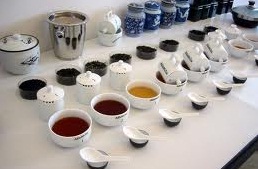What do all those letters mean?
 Black teas, especially those from India and Sri Lanka are graded by quality of the tea leaf itself. Orange Pekoe (pronounced pek’-oh) is actually a grading term meaning whole leaves of uniform size, and does not refer to a type of tea.
Black teas, especially those from India and Sri Lanka are graded by quality of the tea leaf itself. Orange Pekoe (pronounced pek’-oh) is actually a grading term meaning whole leaves of uniform size, and does not refer to a type of tea.
“Orange” has nothing to do with the color of the leaf or the prepared tea. It isn’t known for certain, but it may derive from a from a reference to the Dutch House of Orange, indicating higher quality. The higher grades of tea are used for loose whole leaf teas. Once those higher quality leaves are sold, the bottom grades called fannings (very small, flat, broken pieces of leaf) and dust (very tiny bits or sweepings of tea) are often sold for use in teabags. These grades oversteep in a very short time producing a bitter and overly astringent cup. That’s why we only sell loose leaf tea.
The grading system used includes the following terms, starting with the highest grade:
- Special Fine/Fancy Tippy Golden Flowery Orange Pekoe (SFTGFOP)
- Fine/Fancy Tippy Golden Flowery Orange Pekoe (FTGFOP)
- Tippy Golden Flowery Orange Pekoe (TGFOP)
- Golden Flowery Orange Pekoe (GFOP)
- àFlowery Orange Pekoe (FOP)
- Orange Pekoe (OP)
- Pekoe (P)
- Souchong (S)
- Broken Grades
- Fannings
- Dust
The general rule is that the higher proportion of leaves having golden tips of new leaf buds, the more highly regarded the tea. Exceptional qualities are anything containing a certain proportion of golden tips, FOP or above.
Souchongs are larger broader leaves nearer the bottom of the stems and are often used for China smoked teas. And to confuse things even further, there are corresponding broken grades of leaf such as Broken Orange Pekoe (BOP) or Broken Flowery Orange Pekoe (BFOP).
Green tea is less rigidly graded, but again the grading refers to the leaf and not the prepared tea. You will see such terms as Gunpowder (including delineations such as pinhead and superior), Imperial, Young Hy-son, Hy-son, Twankay, Hy-son skin, and dust used in grading of Chinese teas. Japanese terms include Extra Choisest, Choisest, Choice, Fine, and on down to fannings and dust.
Oolong grades actually refer to the quality of the prepared drink, and not the leaf. The terms range from Finest to Choice, Fine, Superior, Good, and Standard, with many in between. More important than looking for a grade in Oolongs, which doesn’t often appear on packaging, is to look for one produced in Taiwan where the best Oolongs originate.